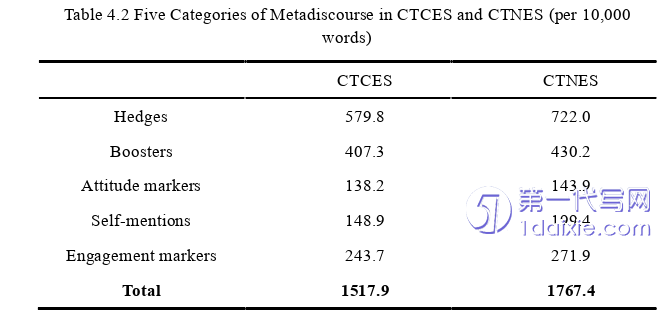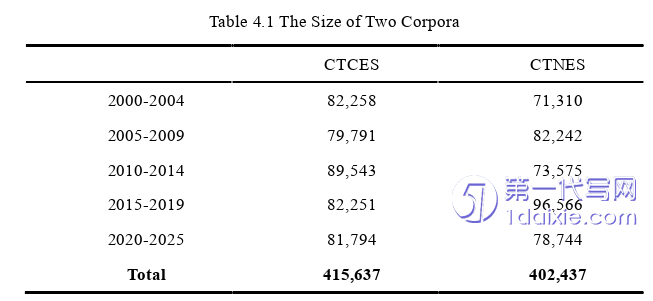本文是一篇英语论文,本研究以Hyland(2005a)互动元话语理论为框架,以50篇中国和英语本族语者英语硕士学位论文为语料,通过语料库的方法对25年来其互动元话语的使用特征进行对比研究和历时研究,旨在揭示中国和英语本族语者硕士学位论文中互动元话语的分布特征和历时变化趋势。
Chapter One Introduction
1.1 Research Background
Since the 1970s, academic discourse has long been seen as reflecting objective and impartial research facts and a rather static exhibition of academic achievements (Mauranen & Bondi, 2003). But in recent years, many scholars and writers have come to realize that academic writing also reflects the writer’s intention, which is to inform the reader. This demonstrates that this kind of language is more than just content, it also aids the reader in understanding and assessing what is being stated. There is a strong interactional relationship between the writer and the reader in academic discourse. According to Hyland (2005a), academic discourse has the characteristics of social interaction and helps readers accept the defining ideas or research findings. In other words, the reader is both viewed as a participant in the discourse and a person who has the power to influence and direct the discourse.
Metadiscourse is the discourse about discourse. It is the method via which the writer constructs the discourse and expresses the stance. Metadiscourse is divided into two types: interactive and interactional metadiscourse. The former highlights the nature of language as a means of describing the world and exchanging information and the latter demonstrates how language can convey the stance, identity, and social relationships of the communicative partners. Academic writings are found to possess rich interpersonal meaning through the use of metadiscourse, particularly interactional metadiscourse, which facilitates communication and comprehension between writers and readers while also assisting writers in expressing their personal viewpoints and stances.

1.2 Research Significance
In theory, using Hyland’s interpersonal metadiscourse theory (2005a) as the framework, this study explores the use of interactional metadiscourse in MA theses written by Chinese English-major students and Native English speakers over the past 25 years (2000-2024). This study provides a systematic and comprehensive perspective through which to analyze distributional patterns and diachronic changes of interactional metadiscourse. This study expands our knowledge of interactional metadiscourse in MA theses by tracking its growth within the academic setting, finding emergent trends, and studying its progression over time. It illuminates how interactional metadiscourse has changed in response to shifting cultural differences, academic standards, and methodologies by focusing on diachronic tendencies. This diachronic analysis advances our knowledge of the complex roles of interactional metadiscourse at various stages of thesis preparation and offers insightful information about how it shapes academic communication.
Furthermore, this study adds empirical data to Hyland’s theoretical framework, which strengthens and keeps current theories relevant in today’s academic discourse studies while also validating existing theories. It proves the usefulness and applicability of Hyland’s framework in examining current academic writing practices by putting theoretical concepts into context with actual cases. Hyland’s metadiscourse theory is validated by this empirical support, which also makes it more credible and applicable in a variety of contexts.
Chapter Two Literature Review
2.1 Definitions of Key Terms
The definition and classification of metadiscourse and interactional metadiscourse are covered in this section
2.1.1 Metadiscourse
Metadiscourse, first put forth by Zellig Harris in 1959, is considered as a method for interpreting language in use. It represents the writer’s attempts to guide a reader’s view of a text and serves as a strategy to help readers comprehend and attract the writer’s attention. Metadiscourse is usually referred to as “discourse about discourse”, but its definition remains a subject of debate.
Metadiscourse has been investigated and analyzed from various perspectives, with different terminology. In his book Theories of Communication, Rossiter (1974) referred to metadiscourse as “metacommunication”. Furthermore, Keller (1979) investigated metadiscourse via the lens of psycholinguistics and coined the term “gambits”, which serves four functions: labeling the entire block, organizing turn-taking, describing a writer’s cognitive state, and determining if talks are exchanged smoothly. Schiffrin (1980) investigated metadiscourse from a sociolinguistics perspective and coined the term “metatalk”, which suggests that speakers use language to explain metadiscourse in discussions, such as “I am telling you”. In his 1981 book Style: Ten Lessons in Clarity and Grace, William used the word “metadiscourse” for the first time in writing studies. With reference to Halliday’s meta-functional theory of language, Vande Kopple (1985, 2002), Crismore (1989) and Hyland (1998, 2005) examined metadiscourse from the perspectives of functional linguistics.
2.2 Relevant ResearchI
in time, whereas diachronic study examines how phenomena evolve across time. The researcher will first categorize the relevant metadiscourse studies from a synchronic perspective and subsequently from a diachronic one in the section that follows. The synchronic perspective is subdivided into different genres, different users, different disciplines and so on. However, there is no extra classification of diachronic studies, because diachronic studies pertaining to metadiscourse have only recently gained popularity and are therefore still relatively scarce.
2.2.1 Metadiscourse Use across Genres
Some studies have explored the use of interactional metadiscourse in different genres, such as book reviews, journal articles, master’s thesis, doctoral theses and so
Tse and Hyland (2006) investigated the frequency of metadiscourse in the book review from three disciplines and demonstrate how these writers employ metadiscourse in various topics. The research shows that the use of metadiscourse can be viewed as a pragmatic tactic used by writers to adapt their social purposes to the formal constraints of the genre, which not only relies on readers’ competence with disciplinary knowledge of the field, but also on an interpretive framework that incorporates acceptable social interactions. Differently, Biber (2006) explored the use of stance markers in spoken and written discourse. Qin and Uccelli (2019) examined the use of metadiscourse markers by Foreign Language learners both in academic and colloquial writing.
Chapter Three Research Methodology ............................... 28
3.1 Research Questions ............................ 28
3.2 Data Collection ......................................... 28
3.3 Research Instruments ............................ 31
Chapter Four Results and Discussion ......................... 35
4.1 Distribution Patterns of Interactional Metadiscourse ...................... 35
4.1.1 An Overview of Distributional Patterns ................. 35
4.1.2 Distribution of Five Categories ................... 36
Chapter Five Conclusion ............................ 66
5.1 Major Findings ................................... 66
5.2 Implications ............................... 70
5.3 Limitations and Suggestions ............................. 71
Chapter Four Results and Discussion
4.1 Distribution Patterns of Interactional Metadiscourse
In this part, the writer analyzed the data and made further discussion about distributional patterns of the use of interactional metadiscourse in MA theses written by Chinese English-major students by comparing them with those written by native English speakers in the field of applied linguistics from 2000 to 2024. First, it presents an overview of the distributional patterns, setting the stage for a detailed exploration of the five categories of interactional metadiscourse: hedges, boosters, attitude markers, self-mentions, and engagement markers. Each category’s distribution is analyzed separately to understand how often and in what ways they are used.

Chapter Five Conclusion
5.1 Major Findings
This study conducts a diachronic study on the use of interactional metadiscourse, aiming to identify distributional patterns and diachronic changes of the use of interactional metadiscourse in 50 MA theses written by Chinese English-major students and native English speakers in the field of applied linguistics from 2000 to 2024. Based on the analysis in the previous chapter, the main conclusions of this study could be summed up as follows:
For the distributional patterns of interactional metadiscourse in MA theses, both Chinese and American postgraduates frequently employ interactional markers in their MA theses. Both of these two groups use more hedges and boosters to create the discourse space, and fewer attitude markers and self-mentions to express personal feelings. Specifically, both Chinese English-major students and native English speakers use hedges more frequently, indicating that students are cautious when elaborating and explaining the findings and results of their research and that they wish to create a friendly and open communication environment. However, the Chinese students use fewer hedges overall than the native English speakers, which may be related to the cultural, linguistic, and academic differences. Additionally, these two groups use boosters frequently, indicating that postgraduates wish to demonstrate their confidence in research findings and related subjects. While Chinese graduate students in the Chinese academic context are more likely to use adjectives and adverbs to increase certainty, native English speakers are more likely to use verbs and nouns to bolster the credibility of arguments. Compared to the two aforementioned divisions, attitude markers are used far less frequently. I
reference(omitted)
